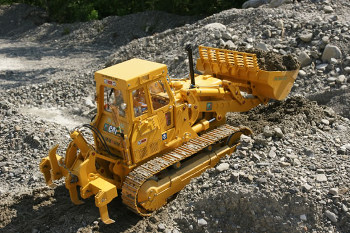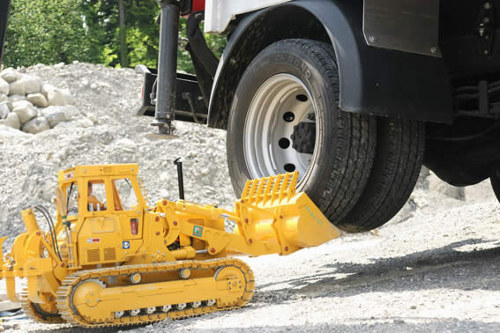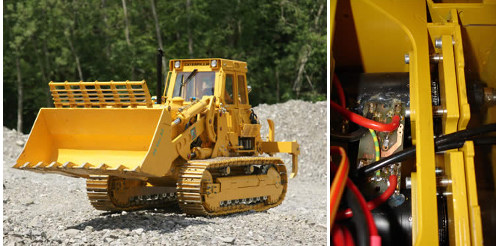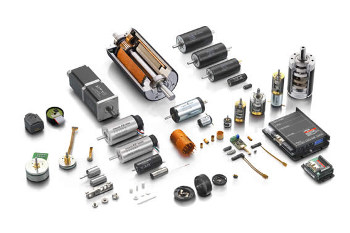 |
| March 25, 2014 | Volume 10 Issue 12 |
Designfax weekly eMagazine
Archives
Partners
Manufacturing Center
Product Spotlight
Modern Applications News
Metalworking Ideas For
Today's Job Shops
Tooling and Production
Strategies for large
metalworking plants
Wheels:
Motors from maxon power mini Caterpillar model
By Anja Schutz, Editor, maxon motor ag

This true-to-life, 1:8-scale model of a Caterpillar front-end loader was designed and built in only 13 months. [Photo: Marcel Sigrist]
Maxon drives can play an important role in model making. Many model locomotives run their rounds powered by maxon motors. But even crazier things can be found in the world of model making, like the bright yellow Cat track loader built by Marcel Sigrist, a hobby model maker from Central Switzerland. Over a period of approximately two years, Sigrist built three true-to-life Trax Cat 983B model loaders at a scale of 1:8. These miniature excavators are driven by maxon motors.
The famed yellow Caterpillar machines are usually gigantic and awe the boy in every man. For Sigrist, nothing seemed more logical than building a model of the loader. But he was not satisfied with building a simple model. After intensive research and studying the original spare-parts manual with exploded views, he started planning and building the remote-controlled miniature loader based on photos and measurements taken on the "real" Cat loader. After eight months of intensive CAD planning, the first drawing with a scale of 1:8 was finished. The model was to have dimensions of 105 cm long, 38 cm wide, 44 cm high, and a weight of 70 kg.

With a bit of trick photography, the mini loader can even lift trucks. In reality, of course, the fully functional model does not have quite so much power. [Photo: Marcel Sigrist]
The heart of the Cat: the drive and the electronics
As early as the planning phase, Sigrist thought of the motors and gearheads. Only maxon motors were considered for the project. The original loader uses spur toothing, therefore it was clear from the start that the model would also use this version. On each traction side, two maxon DC motors with 150 W were connected by means of a toothed belt drive and positioned perpendicularly with a 20:1 worm gear. This gives the loader the required power. A controller for track vehicle models was installed as an electronic component. It has a voltage of 12 V and two times 50-A traction current.

The model loader is driven by 150-W maxon DC motors mounted below it. [Photo: Marcel Sigrist]
Simple maintenance of the electronics was a prerequisite for the installation. To this end, all hydraulic and electronic components were installed in a drawer system. Thus, the hydraulic lines can be removed with minimal effort and all technical components can be accessed easily, in case of an emergency, by opening the drawers. This carrier system contains the hydraulic pump with its motor, the controller for the hydraulic motor, as well as the oil tank with filler neck and de-aeration equipment. The second component is the hydraulic valves with servo systems for the various functions.

Drives by maxon have a modular design: Combine brushless (EC) and brushed DC motors with gearheads, sensors, brakes, and control electronics.
The entire SMX sound module, including speakers, was also built on this unit. Two battery blocks (NiMH) with a voltage of 12 V (12 A/h) were used for the power supply. This makes it possible to operate the model track loader for up to an hour. After all parts of the mini track loader were painted, the assembly work started. After only 13 months, the first of three model loaders was finished. This was followed by a successful trial run (as pictured in this article).
Not even three months later, model number 2 was finished, followed by model 3 a mere three months later.
"What I especially liked about this project was the fact that, when I started out, nothing on this model could be bought as a prefabricated part," says Sigrist. "Planning, measuring, and drawing it to get reliable construction plans was a special challenge. In spite of referencing the spare parts book, I can proudly state, 'I developed it myself.'"
Source: maxon motor
Published March 2014
Rate this article
View our terms of use and privacy policy
